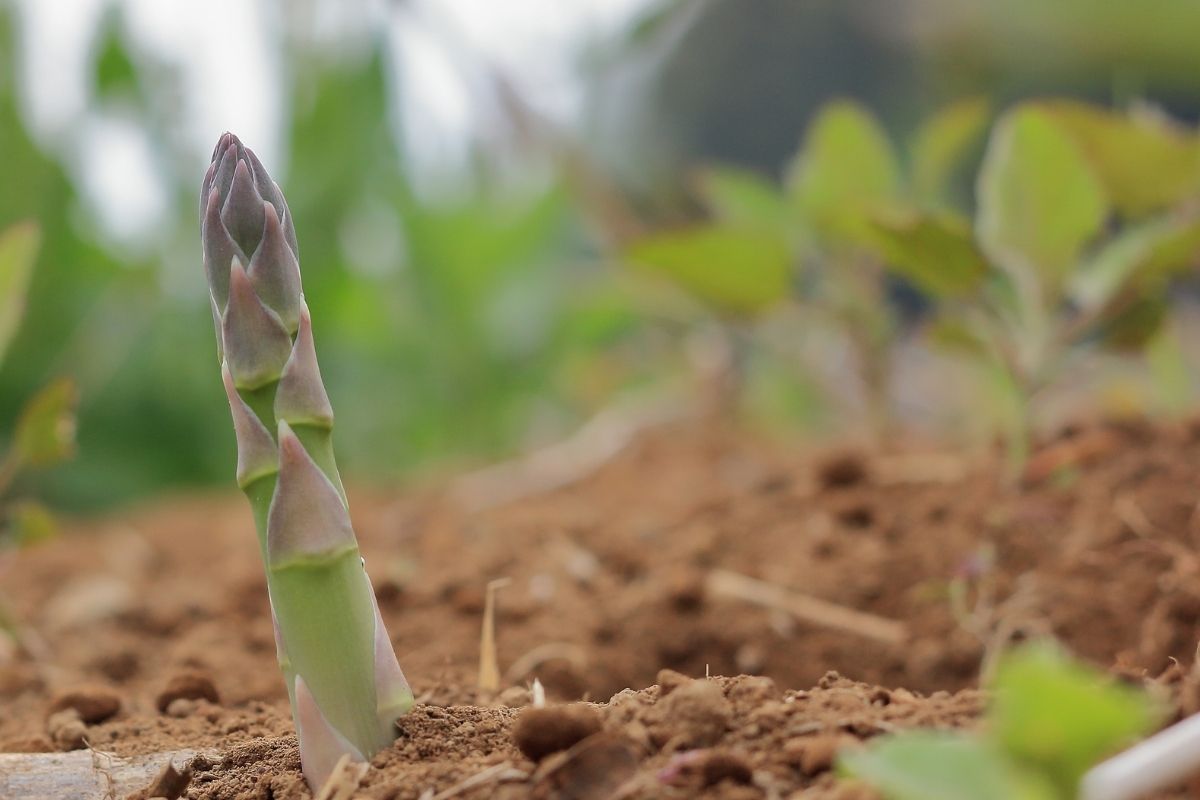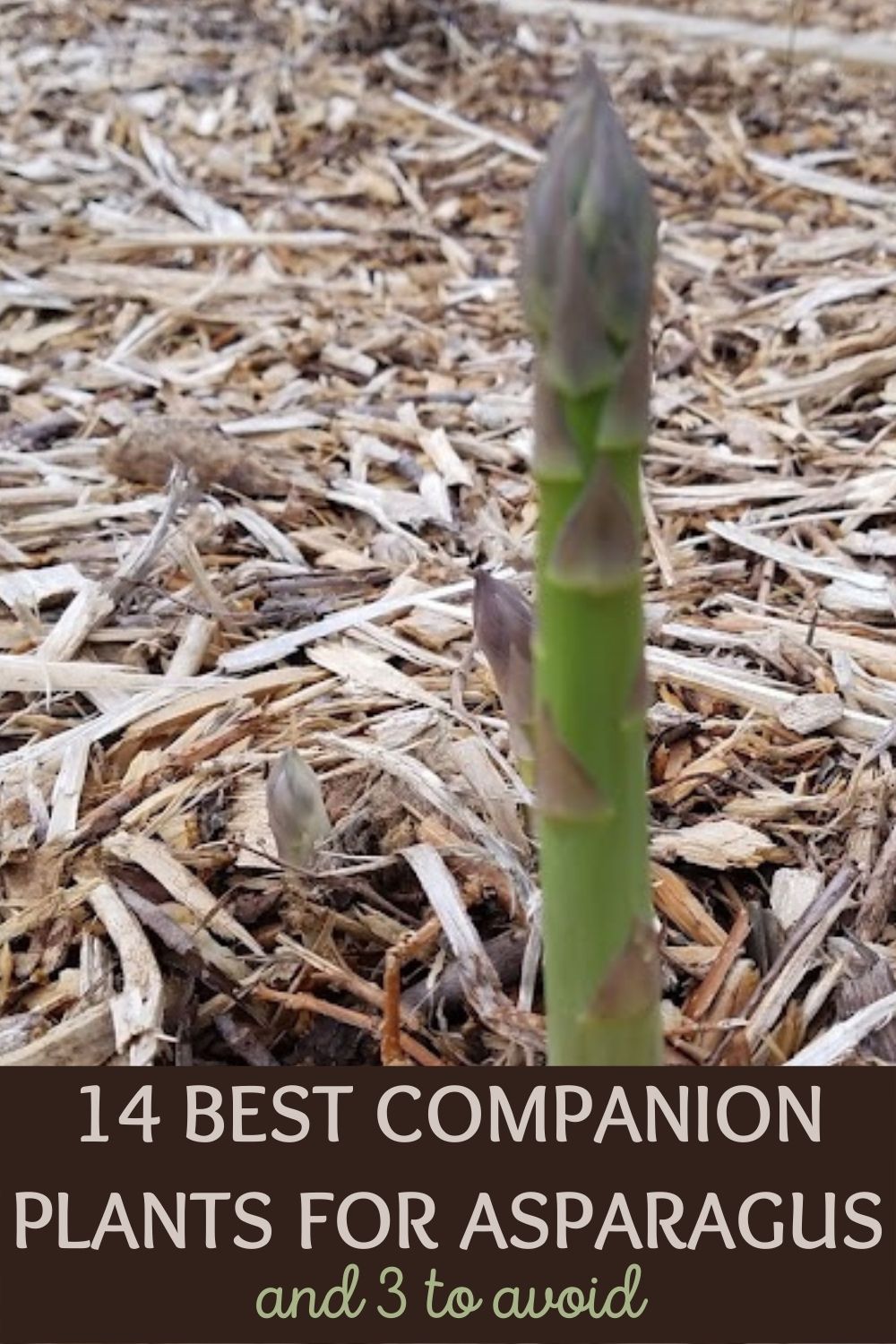Companion planting with perennials like asparagus can seem a bit daunting at first since they occupy a permanent space in the garden. However, interplanting perennials (and mixing in a few annuals, too) can be very rewarding. Check out the tips below on the best companion plants for asparagus, as well as which plants should be grown somewhere else.

I often say that one of the first things I will do when I finally buy my own farm is plant asparagus and rhubarb. These early spring vegetables take a couple of years to get established, but then they faithfully produce a crop every year for decades!
What is companion planting?
Companion planting involves growing multiple types of plants together for benefits like pest control, improved growth, and even better flavor. Check out our Companion Planting Guide to learn more about companion planting and find additional companion plant lists for other vegetables, herbs, and flowers.
Best Companion Plants for Asparagus
Because asparagus has deep roots, it should be paired with shallow-rooted plants. A winning combination for a perennial vegetable bed is asparagus, strawberries, rhubarb, and horseradish. If you’d like to throw in some annual vegetables or herbs, I have some suggestions for those too!
1. Strawberry
Strawberries act as an excellent groundcover between rows of asparagus. Asparagus should be planted in rows spaced two feet apart (with two-foot spacing between plants as well), leaving plenty of room to tuck in a row of strawberries down the center, with one-foot plant spacing.
2. Rhubarb
Rhubarb and strawberries are a winning spring combination, so it makes sense to include both in your perennial food garden. Plant rhubarb at the north end of the asparagus patch to reduce the shading of the other plants. When you harvest the stalks, remove the large, flat leaves in the garden and lay them down to serve as an effective weed-suppressing mulch.
3. Horseradish
Plant horseradish near the rhubarb at the north end of the garden, since it grows to about the same height and doesn’t mind shade from the asparagus ferns. Because it can become quite aggressive, consider planting horseradish in a raised bed if you don’t want to dig it up and replant it every year.
4. Tomato
Tomato plants repel the dreaded asparagus beetle by releasing solanine chemicals. In turn, asparagus deters nematodes that attack tomatoes. To avoid damaging the roots of your asparagus, plant tomatoes along the edges of the asparagus bed rather than between rows.
5. Eggplant
Because they belong to the same family as tomatoes, eggplants also make great companions for asparagus. They, too, deter asparagus beetles and benefit from asparagus repelling nematodes. Again, plant them along the perimeter of the asparagus patch to prevent competition among the roots of the different plants.
6. Lettuce
Low-growing, leafy greens like lettuce can be grown between rows of asparagus as a ground cover. Because it matures relatively quickly and does not develop significant roots, lettuce will not compete with asparagus. Lettuce can also benefit from the dappled shade cast by asparagus foliage.
7. Spinach
Like lettuce, spinach grows well between asparagus rows. It, too, matures quickly with shallow roots and weed-suppressing leaves and appreciates the cooling shade from asparagus ferns.
8. Basil
Plant basil among the tomatoes along the edge of your asparagus patch to deter pests like asparagus beetles and tomato hornworms. If you let it flower, basil will also attract beneficial insects (here’s how to use basil flowers).
9. Cilantro
With its shallow roots and great appreciation for cooling shade, cilantro will thrive between rows of asparagus. In turn, the flowers of cilantro attract beneficial insects to the garden. BTW, did you know that cilantro flowers are edible?
10. Dill
The large, umbrella-like, yellow flower clusters of dill attract pollinators and other beneficial insects. Like cilantro, it has shallow roots and thus can be planted either between asparagus rows or around the perimeter of the bed.
11. Parsley
Parsley also invites beneficial insects into the garden. It specifically acts as a host to swallowtail butterflies, an important native pollinator. Parsley’s strong fragrance may also deter some insect pests.
12. Marigold
Most gardeners know that marigolds are good flowers to have around. Plant them near asparagus to deter asparagus beetles, aphids, nematodes, and whiteflies.
13. Nasturtium
Typically a vining plant, nasturtium provides good ground cover while also attracting beneficial insects with its bright flowers. Nasturtiums can also be planted as a trap crop for some pests. Check out our guide to growing nasturtium.
14. Petunia
Bright, cheery petunias attract pollinators and other beneficial insects while also deterring insect pests like aphids.
Worst Companion Plants for Asparagus
Some plants, especially those with deep roots, should not be planted too close to asparagus. Here are three that need to be kept at a distance.
1. Alliums
Alliums, or members of the onion family, absorb a lot of nutrients and take a long time to grow. As a result, planting onions, garlic, chives, or similar plants near asparagus can result in stunted asparagus growth.
2. Carrots
With their long taproots, carrots may compete with asparagus roots if grown too close. Plus, carrots don’t grow well with some asparagus companion plants, like dill.
3. Potatoes
Potatoes also have deep roots and use the same level of soil as asparagus, thus competing with asparagus and potentially disrupting or damaging its root system.
Use companion planting to design the perfect perennial food garden, enabling you to harvest not only asparagus but also rhubarb, strawberries, and horseradish. For added diversity and bounty, mix in some beneficial annual vegetables, herbs, and flowers as well, and watch your garden flourish.


















Companion Planting Guide (Including 7 Benefits Of Polyculture)
Tuesday 29th of March 2022
[…] Companion plants for asparagus […]